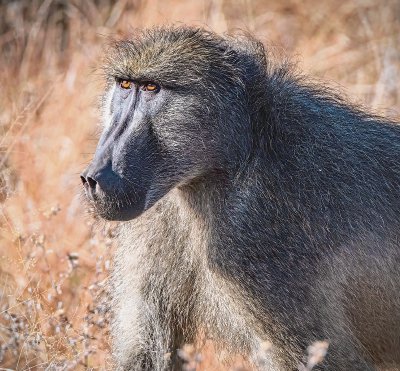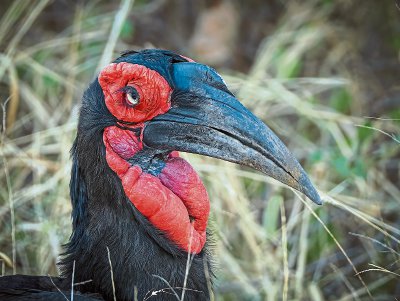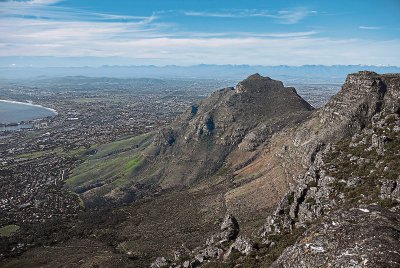By Paul Bradley
MOST households have occasional ‘big years’: certain anniversaries or achievements it’s nice to mark by doing special things.
For several reasons, we’ve been having a Big 2025, and of the things we decided to do to mark it, the centrepiece was one of those long-haul, long-fingered trips we’d talked about for a while – a trip across South Africa, the ‘Rainbow Country.’
Be warned, it’s a long trip; if you don’t like flying, it is cramping, and numbingly, boringly long. That’s one reason why we hadn’t done it before. But a month ago we finally did it, flying from Derry to Heathrow, then from Heathrow to Johannesburg (which on its own is 11 hours). It’s a huge, slightly intimidating country, and one for which it was hard to pack: what do you take to cover wilderness, city, coast and mountain, in temperatures ranging from a morning three degrees in the dry-season East to a daytime 24 in the wet-season West?
We gentled ourselves in with a first stop less gentle in retrospect than it seemed at the time: the Apartheid Museum in Johannesburg, a display of the racist regime that ran there from 1948 to 1994. It tells the story through video and artifacts like Nelson Mandela’s car (you can feel the reverence for Mandela everywhere in the country), but while it’s still a dark and unfinished story, the museum does at least show the slow arc towards justice.
Then it was a two-day safari in Kruger, in some ways the most appetising part. But it’s not the glamorous adventure we perhaps imagine: jeeps are not built for comfort, and the (very) early mornings are cold (June is the winter season there, and one of our drivers brought welcome hot water bottles). The excitement is real, though, and the African dawns are a marvel of vividly striped cloud. In any case your chilly lobes are forgotten the moment you first encounter those animals: breakfasting giraffe 20 feet away peering curiously down at you, warthogs out on dusty warthog business, somehow looking like they’re muttering to themselves about all the things they need to get done. We only saw lions from a distance, but a leopard dozing in a tree was completely unfazed by us, and there were many elephants and buffalo, not to mention a family of freshly-blooded wild dogs, and one solitary, delicate Steenbok antelope. For birders (and we are two) there are many highlights – though for me it was hard to top the encounter with a magnificent ground hornbill, haughty and long-lashed and just a few yards away.

A pensive Baboon.
The Zulu battlefields – we’ve all seen the film – were a real change of tone and setting. At the 1879 battles (between the Zulu and British forces) of Isandlwana and Rorke’s Drift, up to 7,000 people died, and while there are the usual formal monuments at the sites, it’s the small cairns carefully marking graves in the endless long brown grasses that give the place its atmosphere. Rorke’s Drift was the site of the battle shown in the film Zulu, and we were able to visit the grave of the man whose home it once was: it turns out he was an Irish prospector called James Rorke, whose trading post was welcomed by the Zulu, but who infamously committed suicide in 1875 when the gin supplies he had ordered went astray.
The next few days took us into easier, more tourist areas. Knysna’s reserves and beauty spots make for stunning walks, but we also began to see more modern shops catering to tourist needs: carvings, paintings, decorated ostrich eggs. Some were beautiful, some left you wondering how authentic they really were, but the prices were certainly higher than they had been in the East. It’s a trend we noticed more as we travelled further west into the Winelands, relaxed towns like Stellenbosch with Cape Dutch architecture and thriving art shops: yes, you will absolutely find something you love there. And a bit of wine-tasting passes an afternoon nicely, though, in my ignorance, I was surprised that white wine is more popular than red there.
THE ‘MOTHER CITY’
Cape Town, the Mother City, was our last stop after over 2,000 miles, and by the time we got there we had read and heard so much about scams and muggings that we were feeling a bit wary about it. But we were also weary, so the first day’s torrential rain was actually a perfect excuse for a long lunch and an early night. The next day was dry, but Table Mountain was still smothered in cloud and closed to visitors. Since the forecast for the next day (our last) was also damp, we wrote off the idea of getting to the top, and took a tour of the city and surrounds: much of it has the relatively anonymous feel of many big cities, but the central (tightly policed) Waterfront area is relaxed and lively at all times, and a good place for dining while watching seals. Some of the township areas we passed through are still strikingly poor: shacks and shanties shoulder-to-shoulder, almost invariably topped with satellite dishes, residents busily moving among them, smiling children in neat uniforms waving. Of course we visited the penguins at Boulders Beach too, and the notorious and spectacular Cape of Good Hope: heavy skies, thousands of cormorants, young gulls earning their wings on the constant wind, an end-of the-earth kind of feeling.

A striking Hornbill.
Then, on our last day, it was obvious that the forecasts had been wrong: it was gloriously blue, and Table Mountain had reopened. After a quick Belgian beer at Den Anker (yes, you can eat and drink very well here), we took a taxi there, and the driver waited for us at the bottom of the cable car line while we spent 90 minutes at the top. It’s cold, but absolutely worth it for the views, and felt like the most apt and panoramic way to end our trip. It’s a long journey, and hard work at times, and yes, you should be careful in the big cities in particular, but it’s a fascinating and beautiful country, still ironing out its social problems but filled with welcoming people.
On the way back from Table Mountain our taxi driver (who’d had a sleep while we were up there) launched into a long, detailed story about his bank stealing money from him, to which we weren’t always sure how to respond: we’d been warned so often that people just being chatty were probably up to something, so we were half waiting for him to ask us for money.
Of course he didn’t. He really was just talking, and we felt a little guilty for doubting him. Even in the more out-of-the-ordinary places, not everyone is out to get you.

A beautiful photograph of two Zebra.










